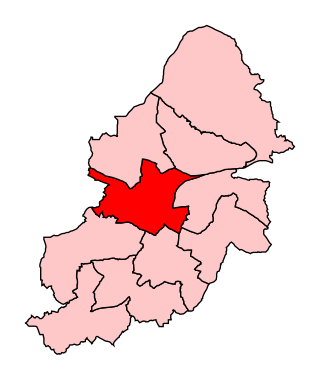Related Research Articles

Birmingham Yardley is a constituency of part of the city of Birmingham represented in the House of Commons of the UK Parliament since 2015 by Jess Phillips of the Labour Party.

Birmingham Edgbaston is a constituency, represented in the House of Commons of the UK Parliament since 2017 by Preet Gill, a Labour Co-op MP.

Birmingham Ladywood is a constituency of part of the city of Birmingham, represented in the House of Commons since 2010 by Shabana Mahmood of the Labour Party.
Saltley is an inner-city area of Birmingham, England, east of the city centre. The area is part of the Washwood Heath ward, and was previously part of the Nechells ward. It is part of the Ladywood constituency in the city.
Birmingham East was a parliamentary constituency in the city of Birmingham, England. It returned one Member of Parliament (MP) to the House of Commons of the Parliament of the United Kingdom, elected by the first-past-the-post voting system.
Birmingham West was a parliamentary constituency represented in the House of Commons of the Parliament of the United Kingdom. It returned one Member of Parliament (MP), elected by the first-past-the-post voting system.
Birmingham, Sparkbrook was a parliamentary constituency centred on the Sparkbrook area of Birmingham. It returned one Member of Parliament (MP) to the House of Commons of the Parliament of the United Kingdom, elected by the first past the post system.
Birmingham Handsworth was a parliamentary constituency centred on the Handsworth district of Birmingham. It returned one Member of Parliament (MP) to the House of Commons of the Parliament of the United Kingdom. It was abolished in 1983.
Birmingham Stechford was a parliamentary constituency centred on the Stechford district of the city of Birmingham. It returned one Member of Parliament (MP) to the House of Commons of the Parliament of the United Kingdom, elected by the first-past-the-post voting system.
Birmingham Deritend was a constituency of the House of Commons of the Parliament of the United Kingdom from 1918 to 1950. It elected one Member of Parliament (MP) by the first-past-the-post system of election.
Birmingham Duddeston was a constituency of the House of Commons of the Parliament of the United Kingdom from 1918 to 1950. It elected one Member of Parliament (MP) by the first-past-the-post system of election.
Birmingham King's Norton was a constituency of the House of Commons of the Parliament of the United Kingdom from 1918 to 1955. It elected one Member of Parliament (MP) by the first-past-the-post system of election.
Birmingham Moseley was a constituency of the House of Commons of the Parliament of the United Kingdom from 1918 to 1950. It elected one Member of Parliament (MP) by the first-past-the-post system of election.
Birmingham All Saints was a parliamentary constituency in the city of Birmingham, which returned one Member of Parliament (MP) to the House of Commons of the Parliament of the United Kingdom. Elections were held using the first-past-the-post voting system.

The First Periodic Review of Westminster constituencies was a review of constituency boundaries for the Westminster Parliament in the United Kingdom carried out by the Boundary Commissions created by the House of Commons Act 1949. The Commissions reported in 1954 and their recommendations took effect for the 1955 general election. Legal action over the procedure for such reviews resulted in the passage of the House of Commons Act 1958.
References
- ↑ "The Parliamentary Constituencies (Birmingham and North Warwickshire) Order 1955. SI 1955/177". Statutory Instruments 1955. Part II. London: Her Majesty's Stationery Office. 1956. pp. 2099–2102.
- ↑ "Election Data 1983". Electoral Calculus. Archived from the original on 15 October 2011. Retrieved 28 June 2017.
- ↑ "Election Data 1987". Electoral Calculus. Archived from the original on 15 October 2011. Retrieved 28 June 2017.
- ↑ "Election Data 1992". Electoral Calculus. Archived from the original on 15 October 2011. Retrieved 28 June 2017.
- Boundaries of Parliamentary Constituencies 1885-1972, compiled and edited by F.W.S. Craig (Parliamentary Reference Publications 1972)
- British Parliamentary Constituencies: A Statistical Compendium, by Ivor Crewe and Anthony Fox (Faber and Faber 1984)
- British Parliamentary Election Results 1950-1973, compiled and edited by F.W.S. Craig (Parliamentary Research Services 1983)
- British Parliamentary Election Results 1974-1983, compiled and edited by F.W.S. Craig (Parliamentary Research Services 1984)
- Britain Votes 4, compiled and edited by F.W.S. Craig (Parliamentary Research Services 1988)
- Britain Votes 5, compiled and edited by Colin Rallings and Michael Thrasher (Parliamentary Research Services - Dartmouth Publishing 1993)
- Who's Who of British Members of Parliament, Volume IV 1945-1979, edited by M. Stenton and S. Lees (Harvester Press 1981)
- Leigh Rayment's Historical List of MPs – Constituencies beginning with "S" (part 3)